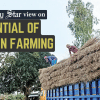Can Bangladesh boost agriculture production to reduce import?

Bangladesh's economy heavily depends on garment exports and remittances for its foreign exchange reserves, with limited diversification in agricultural products. Despite being an agrarian society, it imports key agriculture-related products, straining reserves.
In 2022-2023, over $15 billion was spent on importing cereal grains, oilseeds, dairy products, fruits, vegetables, flour, and fertilizers. This figure is set to double in the next decade considering food requirements and global inflation.
Will the country be able to curb imports and save foreign exchanges? It is possible. At least, a big portion can be saved by giving serious attention and through coordinated planning.
Bangladesh's Agriculture Census 2019 showed a reduction of net arable land from 19.09 million acres in 2008 to 18.68 million acres in 2019. So, we need to raise productivity, use smart technologies, and expand cultivation areas in the fallow land.
Rice is a fundamental part of our daily food staples. The country produces approximately 38 million tonnes of rice annually, according to the Bangladesh Bureau of Statistics. It imports around 1.1 million tonnes of rice each year.
An increase in yield by 3 percent can save $500 million in expenses for rice imports. Despite a rise in crop intensification, rice productivity growth stands at 1 percent, trailing regional peers like India (2.4 percent), Vietnam (1.9 percent), and China (3.7 percent). By using rice transplanters and combined harvesters combined with improved high-yielding varieties, it can achieve this yield.
Bangladesh produces 57 percent of its total demand of 7.5 million tonnes of corn while the rest is imported. If its yield is raised by 20 percent, Bangladesh could meet its requirement and save more than $700 million.
There are approximately 0.45 million hectares of fallow land available, along with around 2 million hectares of single-cropped areas, yet to be utilised.
At present, local ginger only meets 18 percent of the annual demand of 0.45 million tonnes amid the absence of improved ginger varieties. If Bangladesh adopts high-yielding ginger varieties, it can meet its entire demand by cultivating it on 0.02 million hectares instead of the existing 0.01 million hectares. High-yielding variety of potatoes can give us more tubers and save time.
For garlic and onion, Bangladesh is close to fulfilling national requirements. By enhancing yields by a modest 14 percent, it could readily meet the local demand while maintaining the same acreage for garlic cultivation.
The production of onion is higher than the demand. But the problem is almost 30 percent of the produce gets rotten. With proper planning considering cold storage and summer onion varieties, it can mitigate the expenses of $310 million that was spent to import garlic and onion in 2021-22.
During the peak season, around 30 percent of tomatoes are lost due to the lack of proper post-harvest management. By upgrading underutilised potato cold-storage units for multipurpose use, and using varieties of longer shelf-life, we can curtail tomato wastage.
By investing Tk 300 crore to Tk 400 crore in greenhouses, we can supply tomatoes to people. In FY2021-22, Bangladesh imported fresh or chilled tomatoes and processed tomatoes worth $24.76 million.
In FY21-22, Bangladesh imported 0.04 million tonnes of copra (dried kernel of coconut), worth $49.24 million, highlighting a substantial reliance on the import for coconut oil production. The country needs to focus on using high-yielding varieties of coconut. If we can increase the yield by 20 percent, and utilise 0.04 million hectares of barren land mostly in coastal and char areas, we can cut imports.
We spent more than $5.1 billion to import fertilisers in FY2022-23. Urban areas currently generate an average of 25,000 tonnes of solid waste daily. It is estimated that about three tonnes of bio-fertilizer can be produced from every 10 tonnes of waste. If a mega project is taken to enhance the production and use of organic fertiliser, we can cut back on expenses required for chemical fertiliser by about 20 percent.
For proper planning on the agricultural development and replacement of the imports, the government can form an authority under the Prime Minister's Office. The authority will coordinate between ministries to execute large-scale agro-production initiatives.
The author is executive director of ACI Motors Ltd

 For all latest news, follow The Daily Star's Google News channel.
For all latest news, follow The Daily Star's Google News channel. 








Comments